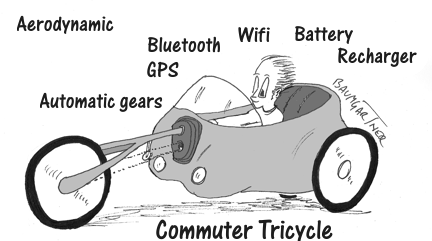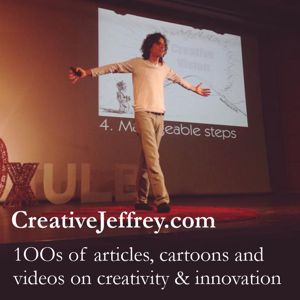
Why Calls to Action are Great for Innovation
By Jeffrey Baumgartner
If you are familiar with structured creative problem solving (CPS), you will know that the method favours problem statements that begin with "In what ways might we...?" This is fine for the method because it invites lots of ideas and suggests that there is not a single right idea. Nevertheless, I don't much like it because I feel it tends to encourage little ideas. I prefer using a call to action which pushes people to build bigger ideas, more elaborate ideas. Better still, a call to action can be formulated to encourage high level creativity or moderate creativity, depending on what kind of solutions you want.
Let's take a look at the options
Imaginary Bicycle Maker
Let us imagine that you and I work in the innovation division of a company that makes bicycles. One day a woman from marketing calls us to a meeting where she informs us that their research has shown that there is a growing interest among young, health-conscious environmentally concerned office workers for commuter bicycles. These people, the marketing department reckons, are looking for a cool, modern bike especially designed for the networked, digitally active commuter. She asks us to come up with some proposals for an innovative commuter bike for this market segment.
Our first step, of course, is to do research in order to get a better feel for these people, the kind of bikes they like, their lifestyles and things like that. If we use anticonventional thinking (and as colleagues, you know I love ACT), we will also ask how commuters feel about their bicycles and our bicycles. We'll ask how our bikes should feel about their owners and how they feel about doing their duty as bikes.
The CPS Way
Now, if you favour CPS, we would bring the group together and brief them on our research. Then we would formulate a problem statement along the lines of "What in what ways might we make our bicycle more appealing to business commuters?" This would doubtless generate a lot of ideas, most of which would probably be features to add to an existing bicycle. From this, you would put together a list of the most compelling ideas and present them to marketing. From there, follow up meetings could determine how to apply the ideas.
The Call to Action
An alternative approach would be a call to action. In it's most basic, least creative formulation, we could formulate a call to action such as: "Describe in detail a new bicycle concept for business commuters." In this scenario, we are not looking for a list of ideas, but a description of a commuter bicycle. Of course that description would include lots of ideas. But instead of a list of disparate ideas, these would be integrated into an overall concept that could be presented to marketing.
We might even go one step further, especially if there is an arty person or two on the team, and ask the team to "Sketch an ideal commuter bicycle concept." If we have suitable materials available, we could even ask them to make a model of the ideal commuter bicycle. Again, the final concept would be a construction of ideas. But the ideas not be a list, but a detailed sketch and notes.
If we want to give marketing a choice, we could even ask the team to "Sketch and describe three different commuter bicycle concepts."
Creative Push
But before we do that, I call the marketing manager and ask her if she wants incremental improvement innovation or if she wants gonzo, radical innovation. And she tells me that she does indeed want something radical and different. And that delights you and I, because we love being super-creative-innovative, don't we?
So, we could formulate a call to action such as, "Design a human powered form of transport for commuters. It must be reasonable to usable on city streets, connectable to the internet and have cool functions."
Alternatively, we might tell the team to, "Describe a pollution free, fun and low cost method for commuters to travel to work every morning. Presume a distance of 10km."
Once we remove the bicycle from the description, but keep in the functionality of the bicycle, we free the team from bicycle ideas and enable them to have more far reaching ideas which can be used. Do you see how using such a call to action makes it relatively easy to be creative? We essentially free the mind from bicycle thoughts and focus it on the limitations of what we want to invent. This can only really work with a call to action where you are building a concept rather than a list of ideas. Ideas alone simply do not go far enough.
Pictures, Models and Stories
When we formulate a call to action, its goal should be something more than a list of ideas. Ideally, aim for a non-verbal goal. In our bicycle example, we asked our team to draw their concepts.
If we have a materials for constructing models, we could even ask the team to build a model. In my experience, this is a lot of fun and leads to great results. Although many people will say they cannot draw, few people have problems making three dimensional things from Styrofoam, Lego building bricks, wooden building blocks and the like.
Sometimes, particularly if the end result needs to be verbal, you can ask the team to write a story. For our marketing manager, the relevant call to action might be, "Imagine a commuter on a bicycle-like vehicle in the year 2025 and tell the story of her commute from leaving her home to arriving at her office 10km away." Although we've put a bicycle back in the call to action, we've made it clear it is a bicycle-like vehicle of the future. More importantly, as the team makes up the story, they think about a typical commute, what happens, what the bicyclist passes, how she might want to interact with others and how she will want to be prepared for work when she arrives. As the team builds the story, the need to think about these things and how the future bicycle might interact with them.
Application
Let us leave our imaginary positions at the bicycle manufacturer and return to our real work. Now, think about the innovation challenges you face. How could you formulate them into calls to action?
Where possible, the goal of the call to action should be something non-verbal, such as a model or a drawing. If it needs to be verbal, it should be for a description of a concept or even a story.
Want some help? Feel free to contact me with an innovation challenge you face and I would be delighted to suggest a call to action or two or three.




